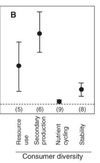Worm et al. 2006. Impacts of biodiversity loss on ocean ecosystem services Flashcards
(14 cards)
Why is the issue of ecosystem services important?
Marine ecosystems provide a wide variety of goods and services, including vital food resources for millions of people. Loss of services such as flood control and waste de- toxification can have disastrous consequences. The role of biodiversity in ecosystem system services had not been tested before
How can declines in marine biodiversity be caused?
Changes in marine biodiversity are directly caused by exploitation, pollution, and habitat destruction, or indirectly through cli- mate change and related perturbations of ocean biogeochemistry
How do the authors examine the effects of variation in marine biodiversity?
They used meta-analysis of published data to examine the effects of variation in marine diversity (genetic or species richness) on primary and secondary productivity, resource use, nutrient cycling, and eco- system stability in 32 controlled experiments.
What is the effect of increased diversity in primary producers?
enhanced all examined ecosystem processes

What is the effect of increased diversity in consumers?
enhanced all examined ecosystem processes

Is there a different effect for species diversity and genetic diversity?
both levels of diversity enhanced ecosystem stability, here defined as the ability to withstand recurrent perturbations. This effect was linked to either increased resistance to disturbance or enhanced recovery afterward.

How can diet help higher levels of the food web?
A number of experiments on diet mixing demonstrated the importance of diverse food sources for secondary production and the channeling of that energy to higher levels in the food web (Fig. 1D). Different diet items were required to optimize different life-history processes (growth, survival, and fecundity), leading to maximum total production in the mixed diet.

How has diversity influenced coastal ecosystems following industrialisation?

systems with higher regional species richness appeared more stable, showing lower rates of collapse and extinction of commercially important fish and invertebrate taxa over time (Fig. 2B, linear regression, P < 0.01
What are the coastal ecosystem services affected by diversity losses?
number of viable (noncollapsed) fisheries (–33%);
provision of nursery habitats such as oyster reefs, seagrass beds, and wetlands (–69%);
and filtering and detoxification services provided by suspension feeders, submerged vegetation, and wetlands. Loss of reefs and coastal wetlands may increase the risk of flooding.
Loss of filtering services probably contributed to declining water quality (18) and the increasing occurrence of harmful algal blooms, fish kills, shellfish and beach closures, and oxygen depletion
An increased number of species invasions over time (Fig. 2E) also coincided with the loss of native biodiversity; again, this is consistent with exper- imental results
What are large marine ecosystems?
ocean regions reaching from estuaries and coastal areas to the seaward boundaries of continental shelves and the outer margins of the major current systems (21). They are characterized by distinct bathym- etry, hydrography, productivity, and food webs.
Collectively, these areas produced 83% of global fisheries yields over the past 50 years.
What is the effect of diversity on LMEs?
we observed that the collapses of LME fisheries occurred at a higher rate in species-poor ecosystems, as compared with species-rich ones.
Species richness varied dramatically across LME, with the proportion of collapsed fisheries decaying exponentially with increasing species richness
Diversity also seemed to increase robustness to overexploitation. Rates of recovery, here defined as any post-collapse increase above the 10% threshold, were positive- ly correlated with fish diversity, a relationship that becomes stronger in time.
Higher taxonomic units (genus and family) produced very similar relationships as species richness
Diversity may support recover by allowing fishers to switch target species, possibly allowing overfished taxa an opportunity to recover. - the number of fished taxa was a log-linear function of species richness
Fished taxa richness was negatively related to the variation in catch from year to year and positively correlated with the total production of catch per year
Describe the trends in species numbers in LMEs.

How is (log) species richness in LMEs is related to:
Collapsed taxa %
Percentage recovery
Productivity in catch
Fished taxa richness

What is the impact of reserves and fisheries closures on biodiversity?
increased species diversity of target and nontarget species, averaging a 23% increase in species richness
These increases in biodiversity were associated with large in- creases in fisheries productivity, as seen in the fourfold average increase in catch per unit of effort in fished areas around the reserves


